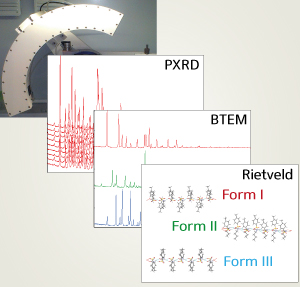Untangling unknown structures in the mix

A new method that combines X-ray diffraction with computational analysis can be used to measure mixtures of unknown solids and identify their individual components. © 2014 A*STAR Institute of Chemical and Engineering Sciences
The characterization of individual components in an unknown crystalline powder mixture is a challenge that has eluded scientists for many years. Now, A*STAR researchers have for the first time invented a methodology to accurately determine the crystal structures present in such mixtures1.
Powder X-ray diffraction (PXRD) is a powerful tool used to determine the structure of crystalline solids. Every solid has its own unique crystal structure which, when hit by X-rays, produces a unique diffraction pattern — a ‘fingerprint’ from which the solid can then be identified and characterized through computational analysis.
However, traditional PXRD works best with pure single-component powders; mixed powders of unknown solids are far more difficult to analyze because the diffraction patterns overlap and are difficult to separate. Another complication is that individual solids can produce slightly different diffraction patterns depending on how the crystals are shaped and orientated in the powder samples.
Marc Garland and co-workers at the A*STAR Institute of Chemical and Engineering Sciences in Singapore have developed a new methodology, the PXRD-BTEM-Rietveld method, which combines two existing techniques to determine the individual crystal structures in a powder mixture.
“Many analytical problems in the chemical sciences involve mixtures of unknown solids,” explains Garland. “The extension of PXRD analysis to these mixtures opens up a myriad of new possibilities for the experimentalist because a purified single-component sample is no longer needed.”
First, Garland and his team used PXRD to obtain diffraction datasets from pre-prepared mixtures of several different powders. They then used their own algorithm, called band-target entropy minimization (BTEM), to sift through the entire dataset, looking for the simplest underlying patterns and to untangle overlapping diffraction patterns.
“BTEM is a blind separation technique,” explains Garland. “By searching for the simplest patterns — those with the smoothest profiles and the least signal disorder — we obtain accurate estimates of each pure component’s diffraction pattern.”
Garland and his team then used computational structure determination, including so-called Rietveld refinement, to obtain the crystal structures for each solid. This allowed the researchers to characterize the unknown components in the mixtures.
“One example of an application for our new technique could be investigating polymorphism in pharmaceuticals,” says Garland. “Each polymorphic pharmaceutical solid has a unique diffraction pattern resulting from its crystal structure, and it is incredibly important to the pharmaceutical industry to identify these from mixtures.”
The researchers plan to further refine their methodology, and hope to eliminate the problem of measuring irregularities due to crystal orientation.
Reference
Schreyer, M., Guo, L., Thirunahari, S., Gao, F. & Garland, M. Simultaneous determination of several crystal structures from powder mixtures: The combination of powder X-ray diffraction, band-target entropy minimization and Rietveld methods. Journal of Applied Crystallography 47, 659–667 (2014).
Associated links
A*STAR article
Media Contact
More Information:
http://www.researchsea.comAll latest news from the category: Physics and Astronomy
This area deals with the fundamental laws and building blocks of nature and how they interact, the properties and the behavior of matter, and research into space and time and their structures.
innovations-report provides in-depth reports and articles on subjects such as astrophysics, laser technologies, nuclear, quantum, particle and solid-state physics, nanotechnologies, planetary research and findings (Mars, Venus) and developments related to the Hubble Telescope.
Newest articles

NASA: Mystery of life’s handedness deepens
The mystery of why life uses molecules with specific orientations has deepened with a NASA-funded discovery that RNA — a key molecule thought to have potentially held the instructions for…

What are the effects of historic lithium mining on water quality?
Study reveals low levels of common contaminants but high levels of other elements in waters associated with an abandoned lithium mine. Lithium ore and mining waste from a historic lithium…

Quantum-inspired design boosts efficiency of heat-to-electricity conversion
Rice engineers take unconventional route to improving thermophotovoltaic systems. Researchers at Rice University have found a new way to improve a key element of thermophotovoltaic (TPV) systems, which convert heat…



